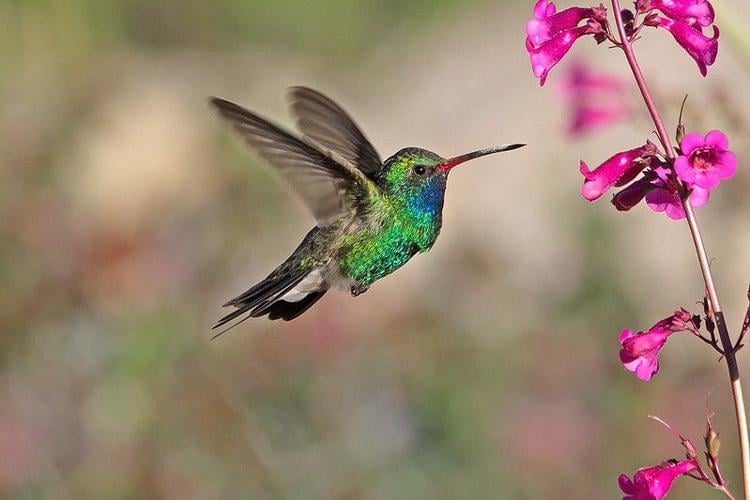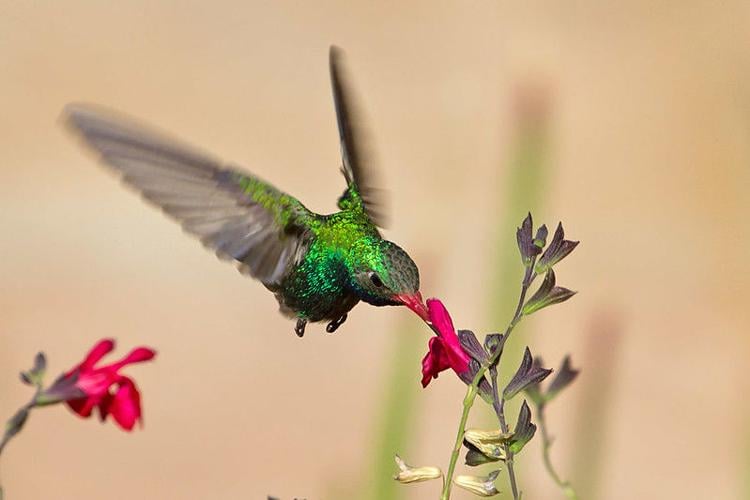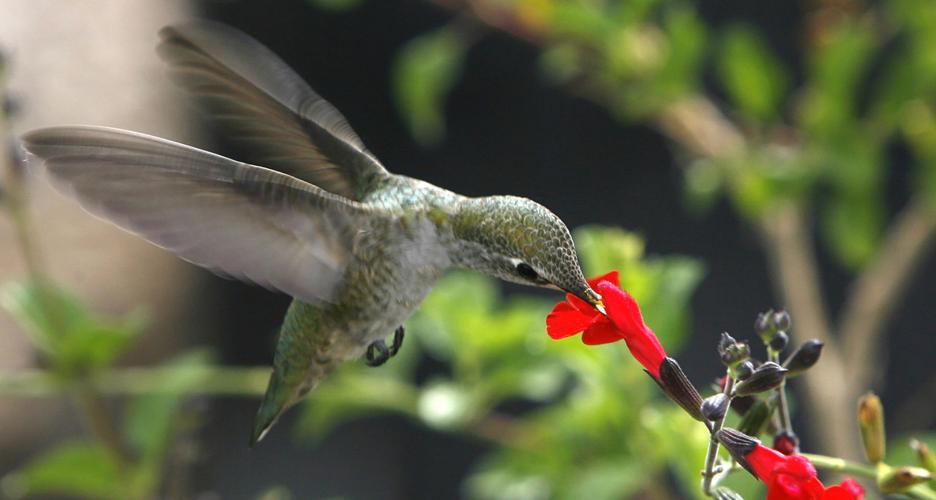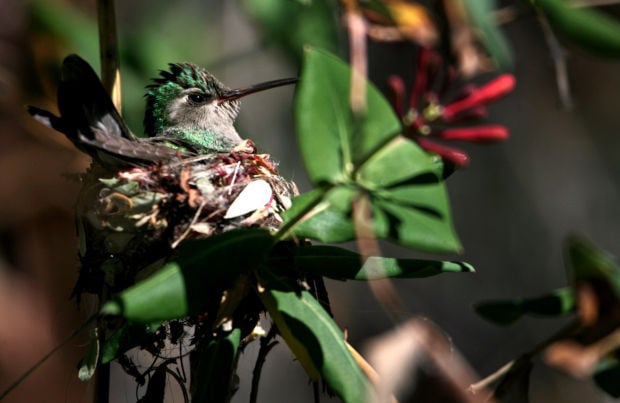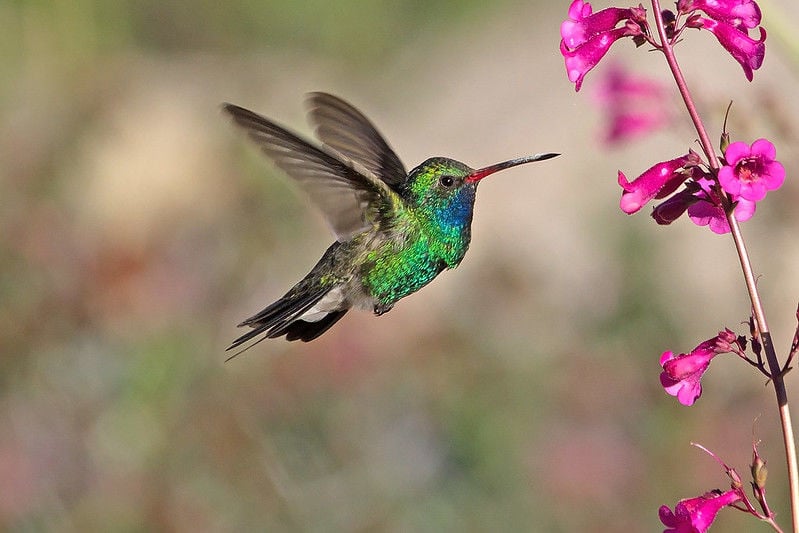Hummingbirds are unbelievably tiny, feisty and fast.
And if you're spending much more time at home lately with constant views of your yard, they can be a welcome sight bringing a bit of delight and whimsy to the repetitive days.
At least that's how we're feeling.
They also seem to be everywhere these days: backyards, front yards, walking paths.
"We're so lucky to be in Tucson where it really is so rich in hummingbirds. It's gotta be one of the best cities in the United States in terms of diversity and sheer numbers," says Jennie MacFarland, a bird conservation biologist with the Tucson Audobon Society. "And this time of year going into our monsoon season, July and August, the hummingbirds love it."
Though they might be small, these birds have a big following.
"They’re amazing animals, they capture people's imaginations and hearts for a reason," MacFarland says.
Here are just a few reasons why.
Hummingbirds ❤️ Tucson and southeastern Arizona
Tucson's abundance of plants and natural landscape and its city-wide wash system make it pretty appealing for hummingbirds, MacFarland says. "But one of the biggest factors that makes us rich in hummingbirds is this influence coming in from the south," she says. "Southeastern Arizona is very much ecologically an extension of Mexico and so that habitat is sort of an extension of the tropics."
The Santa Rita, Santa Catalina and Huachuca Mountains are part of the Madrean Sky Islands found in Arizona, New Mexico and northwestern Mexico.
"These sky islands are literally pulling up many species that normally you would think of as being in Mexico, which really does add to our hummingbird diversity a lot," MacFarland says.
While there are more than 13 different hummingbird species that can regularly be found in southeastern in Arizona, in Tucson you're more likely to see these four: Anna's Hummingbird, Costa's Hummingbird, Broad-Billed Hummingbird and Black-Chinned Hummingbird.
The Anna's Hummingbird is a year-round Tucson resident. The Costa's Hummingbird is more common on the west side of town and moves higher up into the sky islands as the temperatures rise so you'll see them more during spring and fall. The Broad-Billed Hummingbird is more common on the east side year-round as they prefer riparian areas but are more abundant during the spring. The Black-Chinned Hummingbird is a migratory species so they are here in spring and summer.
They enjoy simple things

A hummingbird has it's eyes on a salvia.
Store-bought feeder mixtures can have additives that aren't good for hummingbirds, so all you really need to add to your feeder is a one-to-four ratio of white sugar to water to keep them happy, MacFarland says. You should clean it and replenish with new sugar water several times a week. Pro tip: A UA student's research found that if you space three feeders, all within sight of each other and within a 15-foot area you can minimize hummingbird fights at the feeder and prevent one bird from hogging the nectar, MacFarland says.
They also love the color red, so be sure your feeder has red features (most will), but skip the red dye in your feeder mixture. You can also fill a feeder with plain water or add a water feature to your yard for those hot summer days.
Planting native plants like salvia bushes, penstemons, fairy dusters and desert honeysuckle can help attract more hummingbirds to your yard.
"They do much better in our climate than some of these non-native plants you can get and they are absolutely the best food for hummingbirds in terms of nectar," MacFarland say. "But also these native plants will host tiny insects that are the favorite food of hummingbirds ... hummingbirds eat do eat a lot of insect food, a lot of protein to make it through the year especially mother hummingbirds."
Since bugs are a big part of the hummingbird's diet you'll want to go easy on the pesticides.
They are super moms 💪

A Costa's hummingbird sits in a nest in the hummingbird aviary at the Arizona Sonora Desert Museum in Tucson, Ariz., Friday Mar. 7, 2008. Photo by Greg Bryan/Arizona Daily Star
Hummingbird mamas can do it all.
It's not uncommon for a female hummingbird to manage multiple nests at one time.
"Once (the babies) get big enough that they can regulate their own body temperature… she then has a little bit of time in between feeding them, going to get food and putting it in their mouths, to start working on a nest and she will. They're so efficient," MacFarland says. "And she’ll sometimes even be sitting on eggs before the young fledge and then she sort of takes care of them outside of the nest for a while, teaches them how to be a hummingbird, how to find food and stuff and then she’s already on her way to having new babies by the time those first babies are ready to go out on their own. Female hummingbirds are amazing."
Wow.
They live life in the fast lane

A broad-billed hummingbird enjoys Salvia nectar.
They might be tiny, but hummingbirds are oh-so mighty.
When active, a hummingbird's heart can beat up to 1,260 times per minute and their wings can beat up to 80 times per second, according to the Arizona-Sonora Desert Museum. Those are the highest rates among all bird species. Their body temperature is usually somewhere between 105-109 degrees Fahrenheit.
"They’re truly epic birds and they really do live life on the edge," MacFarland says. "Their breathing rate, their heart rate, their body temperature, everything is sort of thought to be right on the edge of what an animal can do and survive. They are just pushing everything to the limit and they live their lives in the fast lane."
They can also dive at speeds of up to 60 miles per hour, hover and fly backward. NBD.
"They are absolutely epic flyers. They're some of the most precision flyers of the entire bird kingdom," MacFarland says. "They are the only ones that can truly fly backwards … they're like little helicopters of flying and they totally outfly other birds."
They are tiny birds with a big job
Just like butterflies, moths, and bees, hummingbirds are important pollinators.
"Many of our native plants depend on hummingbirds to pollinate them, where they move pollen from one flower to another and that's how these plants reproduce or create seeds," MacFarland says. "It's a very important service they provide to our native plants."
And as insect eaters they also help keep insect populations in balance.
They are sacred in different cultures

A hummingbird can be found on this mural, created by Phoenix muralist Lalo Cota, at 3443 E. Speedway, near The Loft Cinema. Cota is a surrealist painter who draws inspiration from his Mexican-American heritage.
The hummingbird is considered sacred in many cultures in the western hemisphere, MacFarland says.
For the Aztecs, Huitzilopochtli, a war god, was frequently depicted as a hummingbird or wearing hummingbird feathers and the Aztecs believed that fallen warriors were reincarnated as hummingbirds.
"(Hummingbirds) are so little, but they're such fierce fighters," MacFarland says. "They are very evocative and brave, they fight each other, they battle each other which really did not go unnoticed by people."
Other native cultures consider them "bringers of the rain since they come with the flowers," MacFarland say.
"People were noticing natural behaviors and patterns of hummingbirds and it's important to them, it speaks to them and they were then making them an important part of their culture."
They can be found in many places

Kimi, a Tucson homeschool student, works on drawing a hummingbird in the hummingbird exhibit at the Arizona-Sonora Desert Museum earlier this year.
If you don't have any hummingbird visitors in your own yard look for areas that have lots of native landscaping. Hummingbird gardening is really popular in neighborhoods, or even outside businesses, MacFarland says. Look for high concentrations of red or orange blossoms.
The Arizona-Sonora Desert Museum has a hummingbird aviary, but also lots of hummingbirds throughout the grounds because of the vegetation, McFarland says. And, yes the museum is open again but with some restrictions.
Tucson Botanical Gardens, which reopened this week, also has dedicated bird and pollinator gardens to enjoy.
If you don't mind taking a drive, the Ash Canyon Bird Sanctuary in Sierra Vista is a prime hummingbird watching spot and you can see rarer species like the Lucifer Hummingbird. The sanctuary is only allowing 10 visitors at a time right now, however.
The Tucson Audobon Society's Paton Center for Hummingbirds in Patagonia is hummingbird paradise. The center is currently closed, but there is a live webcam you can tune into from home.


